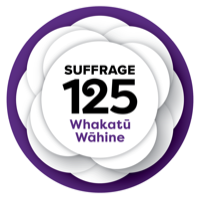On 19 September 1893, Governor Lord Glasgow signed a new Electoral Act into law, and New Zealand became the first self-governing country in the world to enshrine in law the right for women to vote in parliamentary elections.
The road to women getting the right to vote and be able to participate in the political and electoral processes in Aotearoa New Zealand began around 1852 when the New Zealand Constitution Act provided parliamentary franchise to men who met the property-ownership criteria.
Fifteen years later, the Māori Representation Act 1867 provided for the establishment of four Māori seats, but only men could stand for these.
In the last decade of the nineteenth century, women across the country were involved in the suffrage movement fighting for the right to vote to elect members of the New Zealand House of Representatives. The movement involved groups such as the Women’s Christian Temperance Union New Zealand (WCTU) and trade unions.
Wāhine Māori were at the forefront of the suffragist movement, supporting the WCTU in seeking the right to vote for members of the New Zealand House of Representatives and fighting for their right to vote and to stand as members of Te Kotahitanga – the Māori Parliament.
31,872 signatures were collected during a seven-year campaign across 13 petitions. Combined, this was the largest petition ever gathered in Australasia. The largest petition of 25,519 signatures is the only one of the 13 that survived and is now on display in the He Tohu exhibition at the National Library of New Zealand Te Puna Mātauranga o Aotearoa.
The petition contains the signatures of many leading suffragists and feminists, including Kate Sheppard, Marion Hatton, Rachel Reynolds, Ada Wells, Tailoresses’ Union leader Harriet Morison, writer Edith Grossmann, and Christina and Stella Henderson.
This petition was presented to Parliament, and lead to the creation of the Electoral Act 1893 which enshrined in law that all adult women had the right to vote. Less than two months later, 109,461 women enrolled to vote in the 1893 election.
When the Act was passed, suffragists celebrated throughout the country, and congratulations poured in from suffrage campaigners from around the world. In other democracies, women did not begin to gain the right to vote until after the First World War.
New Zealand women still had a long way to go to achieve political equality. They couldn’t stand for Parliament until 1919, and the first woman to become an MP, Elizabeth McCombs (sister of Christina and Stella Henderson), was not elected until 1933 – 40 years after the passing of the Electoral Act 1893.
There have been many other firsts for women in Parliament, including Iriaka Rātana becoming the first wāhine Māori MP in 1949, Jenny Shipley becoming New Zealand’s first woman Prime Minister in 1997, and Georgina Beyer became the first openly transgender MP in the world in 1999. You can read a full list of first for women in Parliament on the Parliament website.
The number of woman MPs did not reach double figures until the mid-1980s and continued to increase following the introduction of the MMP voting system in 1996. In October 2022, women MPs gained an equal share of seats in the House (61 women/60 men) to reach gender-equal representation in Parliament for the first time in New Zealand.
Following the 2023 election, 57 of 123 MPs (or 46.3%) are women.
Since 1933, 197 women have represented New Zealand as MPs. Upon being sworn in as an MP, women MPs receive a camellia brooch with a number engraved on the back of where in this lineage they fall to commemorate this lasting connection between the suffrage movement.
Commemorating Suffrage Day
Each year on 19 September in New Zealand, we mark Suffrage Day to commemorate this milestone and acknowledge the contributions of women who have fought to advance women’s rights and the betterment of our society.

2018 marked the 125th anniversary of women’s suffrage in New Zealand. A national commemoration took place with government agencies, non-governmental organisations, and the wider community coming together through a range of activities across the year.
Read more about Suffrage 125 on the NZHistory website and in our Library.
We recently marked the 130th anniversary of this milestone in 2023. These commemorations included a range of events held across the country, including art exhibitions, museum tours, and panel discussions.
Find out more about the commemorations for Suffrage 130.

